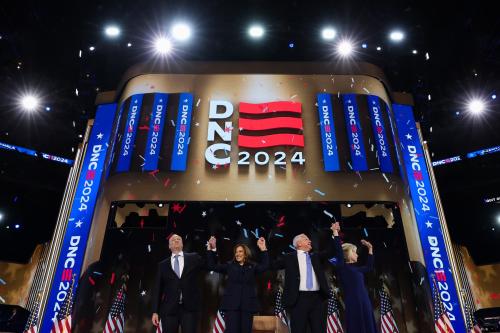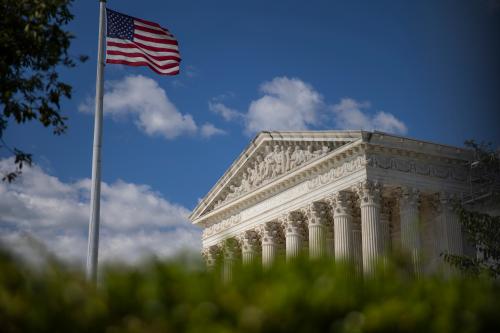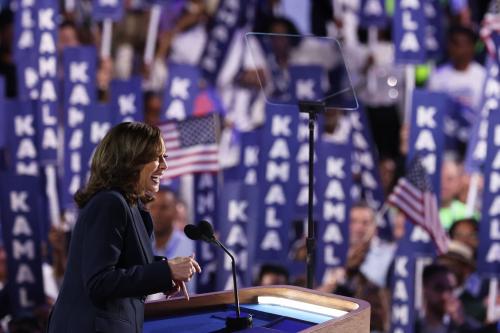Few aspects of campaigns attract as much discussion as television advertisements. Political spots generally represent the largest single expenditure by candidates and often generate considerable news coverage. Yet many observers are not happy with the quality of information presented in ads or the tone of political discourse. Critics worry that the emergence of thirty-second commercials undermine substantive discourse and lead to campaigns that are overly negative. Both raise potential problems for democratic elections.
In looking at campaign ads in this year’s presidential nominating election, prominent campaign ads were more negative than in previous races. Both parties featured open races with a large number of candidates, and the result was negativity levels that were above the historic averages. This finding raises the question of whether this fall’s general election will provide the quality of political discourse needed by voters.
According to an analysis of prominent nomination ads, 61 percent of the 2008 Democratic ads were negative, compared to 43 percent of the Republican ads. Both rates are higher than the average ad negativity of 31 percent for Democrats and 36 percent for Republicans in nominating contests from 1972-2008. Prominent ads were defined as those attracting major media attention.
|
Percentage of Prominent Nomination Ads That Were Negative, 1972-2008 |
|||||||||||
|
|
1972 |
1976 |
1980 |
1984 |
1988 |
1992 |
1996 |
2000 |
2004 |
2008 |
Average |
|
Dem |
14% |
0% |
40% |
50% |
16% |
67% |
0% |
33% |
30% |
61% |
31% |
|
Rep |
0% |
33% |
0% |
33% |
44% |
78% |
63% |
64% |
0% |
43% |
36% |
Policy Specific Ads- Twenty-eight percent of the 2008 GOP and Democratic nomination ads were policy specific. Both numbers are above the historic ad specificity of 13 percent for Democrats and 18 percent for Republicans for nominating battles from 1972-2008.
|
Percentage of Prominent Nomination Ads That Were Policy Specific, 1972-2008 |
|||||||||||
|
|
1972 |
1976 |
1980 |
1984 |
1988 |
1992 |
1996 |
2000 |
2004 |
2008 |
Average |
|
Dem |
0% |
0% |
0% |
10% |
21% |
33% |
0% |
0% |
40% |
28% |
13% |
|
Rep |
0% |
0% |
0% |
0% |
22% |
67% |
21% |
45% |
0% |
28% |
18% |
Content of Ads-
Republicans were more likely to focus on personal qualities (57 percent of all appeals), while Democrats emphasized domestic issues (44 percent) and personal qualities (39 percent). Surprisingly, given the importance of the Iraq War and the War on Terror, neither Democrats nor Republicans devoted much attention to international issues in their advertising campaigns.
The largest category of appeals on the 2008 Democratic side was health and education (22 percent), followed by leadership (17 percent), experience (17 percent), energy and gas prices (11 percent), the economy (6 percent), taxes and budget (6 percent), moral values (6 percent), campaign prospects (6 percent), campaign funding (6 percent), and campaign strategy (6 percent).
On the Republican side, the most common 2008 appeals were moral values (19 percent), immigration (14 percent), extremism (14 percent), taxes and budget (10 percent), leadership (10 percent), trust and honesty (10 percent), the economy (5 percent), health and education (5 percent), crime and violence (5 percent), national defense (5 percent), and experience (5 percent).
|
Content of Prominent Nomination Ads, 2008 |
||
|
|
Democrats |
Republicans |
|
Domestic Issues |
44% |
38% |
|
International Issues |
0% |
5% |
|
Personal Qualities |
39% |
57% |
|
Campaign |
17% |
0% |
Content of News Stories About Ads- Television news stories about nomination ads were less issue-oriented than the spots themselves. Only five percent of the stories about the Democratic campaign focused on domestic issues and 0 percent emphasized international issues. Instead, more than three-quarters (78 percent) of the new stories dwelled on campaign strategy or electoral prospects. Similar patterns were found on the Republican side. Only 19 percent of news stories focused on domestic issues and 0 percent focused on international issues. More than half of the news stories emphasized campaign strategy or prospects.
This suggests that reporters need to focus more on policy substance when reporting on campaign advertisements. Rather than seeing how the ad relates to campaign strategy or affects election prospects, it would be more helpful to viewers if reporters focus on the policy message of advertisements and the degree of accuracy on ad appeals.
|
Content of News Stories About Nomination Ads, 2008 |
||
|
|
Democrats |
Republicans |
|
Domestic Issues |
5% |
19% |
|
International Issues |
0% |
0% |
|
Personal Qualities |
17% |
29% |
|
Campaign |
78% |
52% |
Spending on Ads- The 2008 presidential nomination campaign was a year of record spending on television ads. According to the Wisconsin Advertising Project analysis of TNS Media Intelligence/Campaign Media Analysis Group ad buy data, $200 million was spent on campaign advertising by the leading presidential contenders, $135 million by Democrats and $57 million by Republicans. This included $75 million by Barack Obama, $46 million by Hillary Clinton, $32 million by Mitt Romney, and $11 million by John McCain.
Overall, there were 301 different candidate-produced advertisements, 195 by Democratic candidates and 106 by Republican aspirants. This included 79 ads by Hillary Clinton, 49 by Barack Obama, 32 by John Edwards, 11 by Bill Richardson, 13 by Chris Dodd, 7 by Joe Biden, 2 by Dennis Kucinich, and 2 by Mike Gravel. On the Republican side, Mitt Romney aired 42 different ads, compared to 23 by John McCain, 17 by Rudy Giuliani, 6 by Mike Huckabee, 6 by Fred Thompson, 9 by Ron Paul, 1 by Duncan Hunter, 1 by Sam Brownback, and 1 by Tom Tancredo.
One noteworthy aspect of the Democratic nominating battle was that Obama outspent Clinton on ads in virtually every primary and caucus state. He spent: $9.7 million on ads in Iowa; $7 million in New Hampshire; $1.3 million in Nevada; $1.6 million in South Carolina; $13.2 million on Super Tuesday states such as Alabama, Arizona, Arkansas, Connecticut, Georgia and California; $664,000 in Louisiana, Nebraska and Washington; $2 million in Maryland, Virginia and the District of Columbia; $1.5 million in Wisconsin and Hawaii; $14.5 million in Ohio, Texas and Rhode Island; $433,000 in Mississippi; and $10.7 million in Pennsylvania.
In contrast, Clinton spent: $7.5 million on ads in Iowa; $6.4 million in New Hampshire; $862,000 million in Nevada; $1.5 million in South Carolina; $10.2 million on Super Tuesday states such as Alabama, Arizona, Arkansas, Connecticut, Georgia and California; $203,000 in Louisiana, Nebraska and Washington; $573,000 million in Maryland, Virginia and the District of Columbia; $328,000 million in Wisconsin and Hawaii; $7.8 million in Ohio, Texas and Rhode Island; $70,000 in Mississippi; and $4.9 million in Pennsylvania. This clearly helped Obama communicate his message of “change” to voters.
However, the candidate who spends the most on advertising does not always triumph. On the Republican side, Mitt Romney outspent McCain by a huge margin, yet still lost the nomination. In Iowa, Romney purchased 8,059 ad buys, compared to 1,371 for Mike Huckabee and 1,164 for Fred Thompson. In New Hampshire, Romney purchased 6,790 ad buys, compared to 2,675 for Rudy Giulinai, 2,525 for John McCain, and 90 by Huckabee (based on Campaign Media Analysis Group data). Indeed, from January to November 2007, Romney ran television spots 17,173 times, compared to 945 for McCain. Overall, in the 2007-08 campaign cycle, Romney ran ads around 35,000 times, which was about half of all the ad buys by Republican candidates.
Noteworthy 2008 Nomination Ads
Funniest Ads – Bill Richardson’s job resume ad and John McCain’s ad criticizing Hillary Clinton for funding Woodstock Museum and saying he was “tied up” as a Vietnam POW at the time of the concert
Most Effective Attack Ads – Mitt Romney’s ad on Huckabee’s record (gap between rhetoric and action) and Republican Majority for Choice’s independent ad accusing Romney of flip-flopping on abortion (compares his words between 1994-2007)
Most Effective Response Ad – Barack Obama’s “Pennies” ad criticizing Clinton’s gas tax proposal and citing newspaper sources labeling her idea an election year gimmick
Boldest Ads – John Edwards’s “Rigged” ad saying system is corrupt and substituting Democratic corporate lawyers for Republican ones won’t change the system and Joe Biden’s “Security” ad outlining his plan to separate Iraq into different regions
Best Endorsement Ad – Barack Obama’s Caroline Kennedy ad
Least Effective Endorsement Ad – Jack Nicholson’s independent ad endorsing Hillary Clinton
Most Short-Sighted Ads – Rudy Giuliani’s ad attacking media pundits and commentators and Hillary Clinton’s “What’s Right” ad complaining about pundit talk on who’s up and down
Most Inflammatory Ad – Mitt Romney’s Jihad II ad (graphic images of terrorism, violence and Islamic fundamentalists)
Most Pious Ad – Mike Huckabee’s Christmas ad (direct pitch to Christmas fundamentalists framed by a cross on a bookcase)
Ads Most Frequently Covered by the Media – Hillary Clinton’s 3 a.m. phone ad and North Carolina GOP’s ad attacking Obama and showing words and pictures of Reverend Jeremiah Wright (with tagline saying Obama is too extreme for North Carolina)



